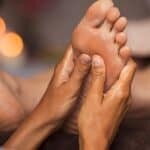
What Causes Cycling Saddle Sores: A Complete Guide
Page Contents
Cycling is an excellent form of exercise, not only does it strengthen your muscles but it also helps to improve your cardiovascular health. However, as with any sport, there are certain risks involved. One of the most common risks for cyclists is the dreaded saddle sore. If you are a cyclist, you probably know how uncomfortable and painful saddle sores can be. In this blog post, we will discuss what causes cycling saddle sores and how to prevent them.
What Is A Saddle Sore
Cycling saddle sores are a common problem for many cyclists, regardless of their level of experience. They are a painful skin irritation that can develop in the area where the skin comes into contact with the bike saddle. The causes of saddle sores are multifactorial, and they can be a result of a combination of pressure, friction, heat, and moisture.
According to a study published in the Journal of Sports Medicine, the prevalence of saddle sores among cyclists ranges from 50% to 91%. The study found that saddle sores were more common in male cyclists, particularly those who spent more time on the bike. The study also identified several risk factors for saddle sores, including wearing improper clothing, poor saddle fit, and poor hygiene.
Another study published in the International Journal of Sports Medicine found that the type of saddle used can also contribute to the development of saddle sores. The study found that cyclists who used narrow or hard saddles had a higher risk of developing saddle sores. This is because narrow saddles can increase pressure on the soft tissues in the perineal area, leading to irritation and inflammation.
What Causes Saddle Sores
There are several factors that can cause saddle sores. One of the main causes is friction between the skin and the saddle. This can be caused by a poorly fitting saddle, wearing the wrong type of shorts, or not using enough chamois cream. Pressure is also a contributing factor, particularly if you spend a lot of time in the saddle. The pressure can cause the skin to become compressed, leading to irritation and soreness.
Heat is another contributing factor, particularly in hot weather. When you sweat, the moisture can create a breeding ground for bacteria, which can lead to infection. Poor hygiene can also contribute to saddle sores. If you don’t clean your bike shorts and saddle regularly, bacteria can build up and cause irritation.
How To Prevent Cycling Saddle Sores
Preventing saddle sores is much easier than treating them. The first step is to make sure you have the right equipment. A good quality saddle that fits you well is essential. You should also invest in a good pair of cycling shorts with a chamois pad. Chamois cream is also an essential tool in preventing saddle sores. Apply it liberally to your skin and the chamois pad before you ride.
Taking regular breaks during long rides can also help to prevent saddle sores. This allows your skin to breathe and helps to relieve pressure. Hygiene is also important in preventing saddle sores. Make sure you clean your bike shorts and saddle after every ride. Showering as soon as possible after a ride is also a good idea, as this helps to reduce the risk of infection.
Do Saddle Sores Go Away?
The question on every cyclist’s mind is, do saddle sores go away? The answer is yes, saddle sores can go away, but it depends on the severity of the sore and the treatment you receive.
Mild saddle sores usually go away on their own within a few days to a week with proper care. This involves cleaning the affected area with mild soap and water, wearing loose-fitting clothing, and allowing the sore to breathe. You can also use over-the-counter creams or ointments to soothe the sore and reduce inflammation.
However, if the saddle sore is severe or infected, it may take longer to heal. In some cases, you may need to see a doctor or a dermatologist for treatment. They may prescribe antibiotics or other medication to treat the infection and reduce inflammation. In rare cases, surgery may be required to drain an abscess or cyst caused by the saddle sore.
Preventing saddle sores is always better than treating them. Properly fitting shorts, a well-fitting saddle, and the use of chamois cream can help reduce the risk of developing saddle sores. Taking frequent breaks during long rides, maintaining good hygiene, and avoiding harsh chemicals or soaps in the affected area can also help prevent saddle sores.
In conclusion, saddle sores can go away, but the time it takes to heal depends on the severity of the sore and the treatment received. To prevent saddle sores, invest in the right cycling equipment, take care of your skin, and listen to your body. If you do experience a saddle sore, take action quickly to prevent further discomfort or complications.
Conclusion
Saddle sores are a common problem for cyclists, but they are also preventable. By taking the right precautions, you can reduce your risk of developing saddle sores and enjoy your rides without discomfort. Remember to invest in good quality equipment, use chamois cream, take regular breaks, and maintain good hygiene.


